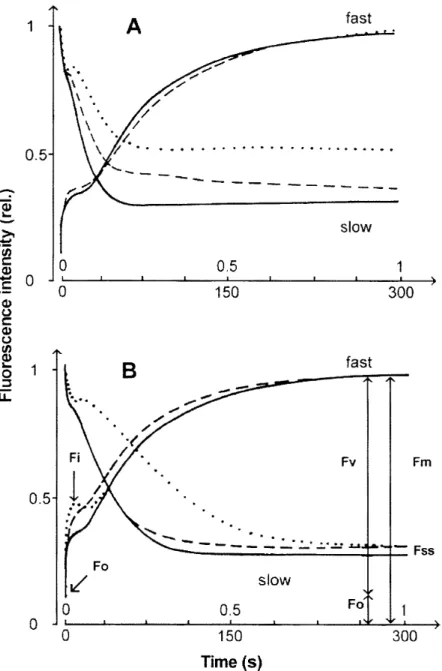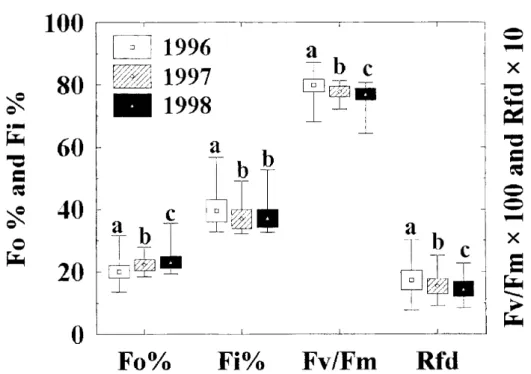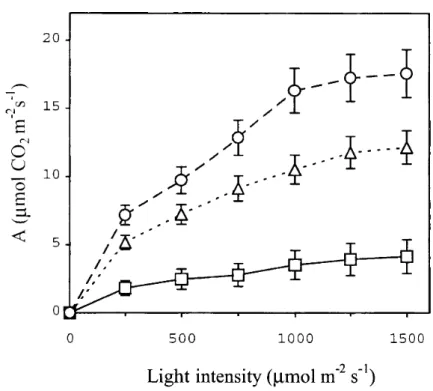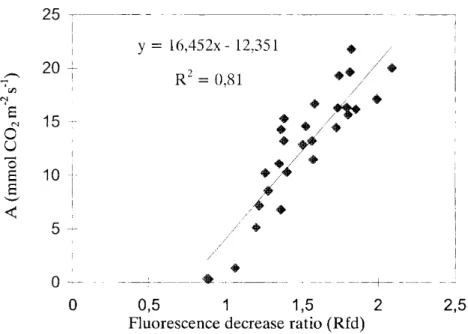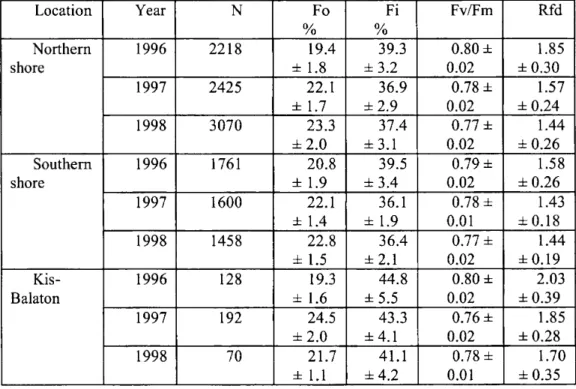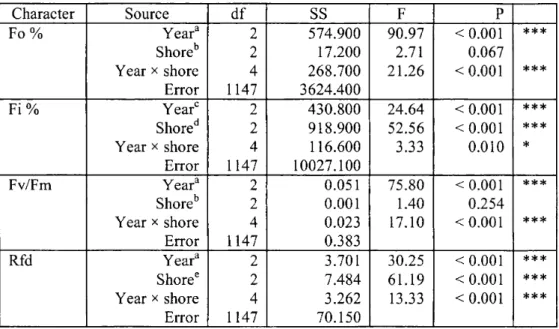Acta Acad. Paed. Agriensis, Sectio Biologiae XXV (2004) 1 3 9 - 1 2 6
Monitoring of the Functional State of Beds of Common Reed (Phragmites australis) in Shallow
Lake Balaton (Hungary) by Means of Chlorophyll Fluorescence Studies
Makrai, L . \ Dulai, S.2, Polyánka, H.1, Ertli, T.1 and Lehoczki, E.1,3
1Department of Botany, Faculty of Science, University of Szeged, H-6701 Szeged, Hungary
" Department of Plant Physiology, Eszterházy Károly College, H-3301 Eger, Hungary
3 Corresponding author, e-mail: lehoczki@bio.u-szeged.hu
Abstract: Comparative measurements of chlorophyll fluorescence induction were performed to study the functional status of reed-stands (Phragmites australis (Cav.) Trin.ex Steud.) along the shores of Lake Balaton. Over 4000 measurements a year of fast and slow chlorophyll fluorescence induction were made on reed leaf samples collected from July until the middle of August during 1996, 1997 and 1998.. The most marked and indicative differences were observed for the ratio of fluorescence decrease (Rfd) values, determined from the slow fluorescence induction measurements. The mean value of Rfd for the overall reed population of Lake Balaton in these three years was around 1.55±0.28, which indicates that the physiological state of the reeds was moderate. However, Rfd values of above 3 or of around 1.2 were also found for some reed-stands. The Rfd values monitored for the reed population of the northern shore in 1996 and 1997 (1.85 and 1.63) were significantly higher than those on the southern side in this period (between 1.58 and 1.44). The mean Rfd values for the southern and northern sides in 1998 were roughly the same, because of the deterioration of the functional state on the northern side. It was also found that the Rfd parameters relate directly to the maximum CO? assimilation rates in reed beds of Lake Balaton, and can be taken as an indication of the physiological state of these beds.
Keywords: reed, Phragmites ausiralis, die-back; functional state;
chlorophyll fluorescence; photosynthesis
Abbreviations used: Fo: initial, Fi: intermediate, and Fm maximum fluorescence level, Fv: variable fluorescence, Fv/Fm: efficiency of open PSII units in darkness, Rfd: ratio of fluorescence decrease for chlorophyll.
Introduction
In recent decades, the common reed (Phragmites australis (Cav.) Trin. ex Steud.), the dominant macrophyte species of shallow lakes in Eastern, Middle and Western Europe, has displayed a significant die-back tendency (Den Hartog et al., 1989; Ostendorp, 1989; Erdei et al. 2001). The tendency to die back is typical of tetraploid (2n=48) reeds that are most commonly indigenous in European lakes, including Lake Balaton (Kovács et al., 1994;
Clevering and Lissner, 1999). However, the primary causes have not yet been unambiguously clarified. Our current knowledge suggests that die-back is a complex situation that can result from several causes, e.g. stabilised water tables, mechanical damage, prolonged insect and fungal infestations, eutrophication and phytotoxin damage to the reed. Human activities resulting in eutrophication are probably acting continuously to promote the dying-back of reed-beds (Armstrong et al., 1996.; Ostendorp, 1989; Den Hartog et al., 1989), though Van der Putten (1977) claims that the eutrophication effect is only an indirect one. With regard to the stabilised water table, the reed-beds in Lake Balaton are probably expanding only vegetatively, via rhizome or ramet fragments. Their die-back may therefore be associated with limited genetic variability within the reed populations.
The exact functional state of the reed-beds at Lake Balaton, which has never been measured to date.
A wide range of studies have established that fluorescence is a sensitive indicator of damage to photosynthesis, to the physiological effects which feedback photosynthesis, and hence to the physiological state of the plants in general (Renger and Schreiber, 1986; Strasser et al., 1987; Lichtenthaler, 1988); it can therefore reveal the effects of stress and environmental factors on plants. It is important that such changes can be expressed by exact numbers, i.e. by the fluorescence induction parameters.
The objective of the present research was to investigate the current functional state of the reeds along the shores of Lake Balaton by the application of chlorophyll fluorescence measurement techniques. To reveal how measurements of chlorophyll fluorescence induction can be applied to problems relating to the dying-back of reed-beds, direct measurements of
Monitoring of Functional state of Reed... 141 C02 assimilation were also carried out, in order to demonstrate the direct correlation between the two methods for reed investigations.
Material and methods
Area of study
At the mean water level, Lake Balaton has a surface area of 594 km2, a mean depth of 3.14 m and a water volume of 1.8 km3. Half of its watershed of 5179 km2 is drained by the River Zala through the Kis-Balaton Reservoir into Keszthely Bay. Lake Balaton has a deep littoral zone on the northern shore and a shallower one in the south. The macro vegetation also differs on the northern and southern shores. On the northern side, continuous stands of reed can be found, bordering the shoreline and extending to the deeper, open water. Along the southern shore, the vegetation is less developed as compared with that on the northern shore, and there are no continuous stands of reed. In an interpretation of the current reed-bed decay in Lake Balaton, the impact of the past 50 years cannot be ignored. From the second half of the 1950s, vaste areas of Lake Balaton became covered by reeds. Between 1958 and 1968, for example this reed-bed growth was approximately 500 ha (from 1376 to 1862 ha). From the 1960s onwards this expansion slowed down, and in the 1970s the process reversed and the reedy areas (reedboss) slowly diminished. Measurements showed a reduction of 10% in 1975, of 30% in 1987 and of a further 10% in 1993 (Virág, 1997). Thus, starting from 1968, the area of reed-beds decreased by 40%, from 1 862 to 1 129 ha.
Expressed in a different way, 3.1% of the surface of the lake was covered by reeds in 1968, as compared with only 1.9% in 1993 (Kovács et al., 1994). At present, the reed areas extend along almost one-half (110 km) of the shoreline of Lake Balaton. A rapid eutrophication of the lake started at the end of the 1960s, and by the 1970, the south-western (Keszthely Bay) areas had become hypertrophic, mostly as a result of the excessive nutrient supply from the River Zala (Heródek, 1986).
Collection of plant material
Measurements were carried out along the shores of Lake Balaton in July and the first half of August in 1996, 1997 and 1998. For determination of the C02 assimilation and fluorescence induction, we gathered the plants together with their rhizomes in 1996. However it later emerged that the upper parts of the plant (approximately 60 cm, 6-7 nodes) were sufficient for these measurements. Each year, the samples were taken from the same locations during the early morning, or late evening. Samples were harvested from the waterward side of the reed-beds from a circles around 5 m in diameter. Until
the measurements were made, the samples were placed in water taken from the location of the sampling and stored in a dark room for a minimum of 5-6 hours. Fluorescence induction measurements were the carried out on the 3rd or 4th leaves from the apex. From the sample leaves kept in the dark, discs in 11 mm in diameter were cut from the upper third of the leaves, and placed in specially-designed sample boxes.
Chlorophyll-a fluorescence measurements
The fast and slow chlorophyll fluorescence induction kinetics (Kautsky effect) were recorded in the 730 nm region on the upper surface of the leaf discs after a 30-min additional dark adaptation in the sample boxes, using the computerized apparatus described by Szigeti et al. (1988). The controlling system allows the simultaneous measurement of fast and slow fluorescence transitions on the same leaf disc. Fo (initial fluorescence), Fi (intermediate fluorescence), Fm (maximum or peak fluorescence), and Fss (steady-state fluorescence) were measured on different time-scales. The quantum flux density of PAR at the surface of the samples was 185 |imol m~2 s"1. Recording of the slow fluorescence kinetics for 5 min was sufficient for the steady-state level to reached and for determination the ratio of the fluorescence decrease Rfd as (Fm-Fss)/Fss).
Gas-exchange measurements
Photosynthetic CO2 assimilation-light curves and chlorophyll fluorescence were measured on the same part of Phragmites leaves. C02
assimilation was measured in normal air (345 ppm C02 and 21% 02) with an infrared gas analyser (LCA-2, Analytical Development Co., Ltd., Hoddesdon, UK). The white light for the activation of photosynthesis was provided by a projector light source (projection lamp, Type 6423, Philips, Germany) through a heat filter (Melles Griot, Irvine, CA). The leaves were exposed for 10 min to white light of different intensities (from dark to 1500 fimol m"2 s"1 PAR) in a Parkinson leaf chamber (PLC-B, Analytical Development Co., Ltd., Hoddesdon, UK) and the C02 fixation was determined. The rates of C02 fixation were calculated by using the equations of Von Caemmerer and Farquhar (1981).
Statistical analyses
For comparisons of means, multivariate analysis of variance (MANOVA) and factorial ANOVA (were used, followed by the Tukey HSD test.
Monitoring of Functional state of Reed... 143
Results
Fluorescence induction measurements on Phragmites leaves along the shores of Lake
Balaton
During the three years, we performed a great number of fast and slow fluorescence induction measurements on the reeds leaves of the along the shores of Lake Balaton and Kis-Balaton, with the aim of determining the functional state of the reed populations. The typical fast and slow chlorophyll fluorescence induction curves are depicted in Fig. 1 for Lake- Balaton (A) and Kis- Balaton (B), with indications of fluorescence parameters. Figure 2 shows the means±DE and minimum-maximum values of Fo, Fi, Fv/Fm and Rfd of the chlorophyll fluorescence induction parameters of reed the leaves, measured in 1996,1997 and 1998, along the shores of Lake Balaton and in Kis-Balaton. Different letters indicate significant difference between years P<0.05. Since no such measurements had previously been carried out at Lake Balaton, the results obtained in 1996 will serve as the basis of our further examinations. The results of the fluorescence induction measurements in 1997 and 1998 revealed a gradual deterioration of the functional state of the reed-beds as compared with the 1996 situation (Fig. 2). The means±DE values of the fast (Fo, Fi and Fv/Fm) and slow (Rfd) chlorophyll fluorescence induction parameters for Phragmites leaves , measured in 1996, 1997 and 1998, along the northern and southern shores of Lake Balaton and Kis-Balaton are presented in Table l.(The reed-stands located between Balatonkenese and Keszthely are referred to as on the northern side, while those located between the holiday resorts of Balatonberény and Balatonakarattya are referred to as on the southern side).
MANOVA analysis of the means of chlorophyll fluorescence induction parameters revealed significant effects of year (Pilai trace=0.380; F=67.0;
df=8, 2290, P <0.001), shore (Pilai trace=0.242; F= 39.0; df=8, 2290;
P0.001), and year by shore interaction (Pilai trace=0.170; F=13.0; df 16, 4;
P<0.001).
For comparisons of means, the differences between the data for the years and shores were analysed by using a factorial ANOVA test (Table 2).
The above results clear by demonstrate that both components of the chlorophyll fluorescence induction kinetics, i.e. the fast fluorescence rise and the slow decline, can be used to describe the functional state of the photosynthetic apparatus. However, from the data in Table 2 it is obvious that the most marked and reliable differences were observed for the Rfd
values resulting from the slow fluorescence induction measurements. The mean Rfd value of 1.55±0.28 calculated from over 13 000 slow fluorescence induction measurements in 1996-1998 indicate a moderate functional state of the reed-beds in Lake Balaton. Outstanding mean values of Rfd (higher than 2) were measured in some northern reed-beds, such as those at Zánka, Keszthely Bay, Balatonkenese, Balatonfüred and the area of Kis-Balaton. In 1996, the Rfd parameters of the reeds at Keszthely Bay and Zánka were measured in several series to be around 3, which indicates the very good physiological state of the reeds. The lowest Rfd values (~1) were measured on the northern side, in the reed-beds around Szigliget Bay and Révfülöp.
Correlation between Rfd values and the rate of CO2 assimilation of Phragmites leaves
During our research programme, measurements were also made to justify the correlation between the Rfd values and the C02 assimilation rates in the reeds. The light responses of the photosynthetic activities for intact reed leaves were measured to determine the light intensity saturation point and the maximum assimilation rate (A). Samples from various locations gave A values between 0.3 and 21.3 pmol C02 m2 s"1, i.e. a wide interval. The fluorescence induction measurements revealed that, in parallel with the increase in the Rfd values, the C02 assimilation rates also increased (Fig. 3).
It is obvious that the maximum assimilation rate correlated with the increase in the Rfd values. To establish the correlation between the maximum C02
fixation rate and Rfd, the corresponding rates of C02 assimilation were plotted against Rfd (Fig. 4). Below an Rfd value of 1, there was no net activity in photosynthesis. Above this level, however, there was a strong linear correlation between the two variables, characterized by R2=0.85, at P 0.0 5. These results unambiguously prove that Rfd, the ratio of the chlorophyll fluorescence decrease, furnishes very similar information on the photosynthetic activity of the reeds to that provided by C02 fixation. Figure 4 can also be regarded as a calibration curve, from which, in the knowledge of Rfd, the activity of C02 assimilation can be determined.
Discussion
In three consecutive years (1996-1998), measurements were made throughout the entire shore area of Lake Balaton and Kis-Balaton, with the aim of monitoring the functional state of the reed population. The results of the fluorescence induction measurements in 1997 and 1998 revealed a gradual deterioration of the functional state of the reed-beds as compared with the 1996 situation. The mean Rfd value of 1.55±0.28 calculated from over 13 000 slow chlorophyll fluorescence induction measurements in this period, indicates a moderate functional state of the reed-beds in Lake
Monitoring of Functional state of Reed... 145 Balaton. The Rfd results on the southern side varied between 1.58 and 1.44, i.e. no appreciable change in the weaker functional state on the southern side. In contrast, the northern side displayed a significant year-by-year deterioration in functional state: the mean Rfd for this three-year period varied between 1.85 and 1.44. In 1998, the average Rfd values for the northern and southern reeds became similar, in consequence of the gradual deterioration of the reed-stands on the northern side. The linear correlation between the maximum assimilation rate of CO2 fixation and Rfd suggested that the C02 assimilation also decreased by 25-30% in this period. From the individual Rfd data of the settlements, we constructed an overall functional state map of the reed areas of Lake Balaton (Lehoczki and Makrai, 1997;
1998). This could be compared with effects relating to the local quality of the lake water, the various forms of chemical contamination, the eutrophication, the age of the reeds, etc. It would be a great challenge to identify the factors with significant impacts on the local differences from the average functional state. Keszthely Bay has been the object of numerous scientific studies, mainly because this is the entry point of the River Zala and the region of most extensive eutrophication. The functional state of the reeds at Keszthely Bay in 1996 (Rfd=1.97±0.23) was outstandingly good, but two years later it had deteriorated to have one of the weakest functional states (Rfd=1.42±0.29). These and other similar results demonstrate that there are dynamic changes year by year, probably caused by different individual factors, which can affect separate regions. Serious problems may be observed in the Szigliget Bay and Becehegy regions (though not much attention is paid to these areas), where the reeds are in the poorest condition of all those on the entire northern side.
In summary, the application of chlorophyll fluorescence induction to monitor the functional state of reed-beds provides a powerful means of linking photosynthesis with higher levels of plant functioning and is of significant potential for research on the die-back of reeds and for the quantitative determination of the effects of environmental factors before visual symptoms develop. The presented results can be utilised in further research with the aim of establishing the concrete reasons for the die-back of reeds.
Acknowledgement: This work was supported by the Balaton Secretariat of the Prime Ministers's Office.
T i m e ( s )
Fig. 1 Examples of fast and slow chlorophyll fluorescence transients of dark-adapted Phragmites leaves typical for Lake Balaton (A) and Kis- Balaton (B) with an indication of the fluorescence induction parameters.
Monitoring of Functional state of Reed... 147
Fo% Fi% Fv/Fm Rfd
Fig. 2 Average±DE with minimum and maximum values of fast (Fo, Fi, and Fv/Fm) and slow (Rfd) chlorophyll fluorescence induction parameters in 1996, 1997 and 1998for the overall area of Lake Balaton. Different letters indicate significant differences between the data for the different years at a level P<0.0 5.
2 1 Light intensity (jamol m~~ s" )
Fig. 3 Light response curves of photosynthesis (assimilation rate, A) for intact leaves in 1996 from different settlements adjacent to Lake Balaton, with different values of Rfd (squares, Rfd =0.95; triangles, Rfd = 1.45;
circles, Rfd = 1.9).
Monitoring of Functional state of Reed... 149
Ou E£
0,5 1 1,5 2
Fluorescence decrease ratio (Rfd) 2,5
Fig. 4 Relationship between the maximum assimilation rate (A) and Rfd values. Corresponding pairs were measured from the same parts of the reed leaves.
Table 1 Means±SE of fast (Fo, Fi, and Fv/Fm) and slow (Rfd) parameters of chlorophyll fluorescence induction of Phragmites leaves, measured in 1996,
1997 and 1998 along the northern and southern shores of Lake Balaton and in Kis-Balaton (N, number of samples).
Location Year N Fo
%
Fi
%
Fv/Fm Rfd
Northern shore
1996 2218 19.4
± 1.8
39.3
±3.2
0.80 ± 0.02
1.85
±0.30 Northern
shore
1997 2425 22.1
± 1.7
36.9
±2.9
0.78 ± 0.02
1.57
±0.24 Northern
shore
1998 3070 23.3
±2.0
37.4
±3.1
0.77 ± 0.02
1.44
±0.26 Southern
shore
1996 1761 20.8
± 1.9
39.5
±3.4
0.79 ± 0.02
1.58
±0.26 Southern
shore
1997 1600 22.1
± 1.4
36.1
± 1.9
0.78 ± 0.01
1.43
±0.18 Southern
shore
1998 1458 22.8
± 1.5
36.4
±2.1
0.77 ± 0.02
1.44
±0.19 Kis-
Balaton 1996 128 19.3
± 1.6
44.8
±5.5
0.80 ± 0.02
2.03
±0.39 Kis-
Balaton
1997 192 24.5
±2.0
43.3
±4.1
0.76 ± 0.02
1.85
±0.28 Kis-
Balaton
1998 70 21.7
± 1.1 41.1
±4.2
0.78 ± 0.01
1.70
±0.35
Monitoring of Functional state of Reed... 151
Table 2 Factorial ANOVA to test the effects of years and shores on the chlorophyll fluorescence induction parameters of Phragmites leaves
Character Source df SS F P
Fo % Year3 2 5 7 4 . 9 0 0 9 0 . 9 7 < 0 . 0 0 1 * * *
Shoreb 2 1 7. 20 0 2 . 7 1 0 . 0 6 7
Year * shore 4 2 6 8 . 7 0 0 2 1 . 2 6 < 0 . 0 0 1 * * *
Error 1 14 7 3 6 2 4 . 4 0 0
Fi% Year0 2 4 3 0 . 8 0 0 2 4 . 6 4 < 0 . 0 0 1 * * *
Shored 2 9 1 8 . 9 0 0 5 2 . 5 6 < 0 . 0 0 1 * * *
Year x shore 4 1 1 6. 6 0 0 3 . 3 3 0 . 0 1 0 *
Error 1 14 7 1 0 0 2 7. 1 0 0
Fv/Fm Yeara 2 0 . 0 5 1 7 5 . 8 0 < 0 . 0 0 1 * * *
Shoreb 2 0 . 00 1 1.40 0 . 2 5 4
Year x shore 4 0 . 0 23 17.10 < 0 . 0 0 1 * * *
Error 1 14 7 0 . 3 8 3
Rfd Year3 2 3 . 7 0 1 3 0 . 2 5 < 0 . 0 0 1 * * *
Shore6 2 7 . 4 8 4 6 1 . 1 9 < 0 . 0 0 1 * * *
Year x shore 4 3 . 2 6 2 13.33 < 0 . 0 0 1 * * *
Error 1 14 7 7 0 . 1 5 0
a The data for all the three years differed significantly from each other.
b The data for the three shores did not differ significantly from each other.
c The data for 1996 differed significantly from those for 1997 and 1998.
d The data for Kis-Balaton differed significantly from those for the northern shore and those for the southern shore.
e The data for all the three shores differed significantly from each other.
References
ARMSTRONG, J., ARMSTRONG, W . AND VAN DER PUTTEN, W . H . ( 1 9 9 6 ) : Phragmites die-back, bud and root deathe blockages within the aeration and vascular systems and the possible role of phytotoxins. New Phytol. 1 33, 3 9 9 - 4 1 4 . VON CAEMMERER, S. AND FARQUHAR, G . D.( 1 9 8 1 ) : Some relationship between the
biochemistry of photosynthesis and the gas exchange. Planta 1 5 3 , 3 7 6 - 3 8 7 . CLEVERING, O., A. AND LISSNER, J. ( 1 99 9) : Taxonony, chromosome numbers,
clonal diversity and population dynamics of Phragmites australis Aquat Bot.
6 4 , 1 8 5 - 2 0 8 .
DEN HARTOG, C., KVÉT, J. AND SUKOPP, H. ( 1 9 8 9 ) : Reed. A common species in decline. Aquat. Bot. 35, 1-4.
ERDEI, L., SZEGLETES, Z., HORVÁTH, F., TARI, I., PÉCSVÁRADI, A . AND DULAI, S.
(2001): Differences in photo respiration, glutamine synthetase activity and polyaminee between fragmented and closed stands of Phragmites australis in Lake Balaton. Aquat. Bot. 65, 165-176.
HAUBER D., WHITE, D. A., POWERS, S. P., AND DEFRANCESCH, F. R. ( 1 9 9 1 ) :
Isozyme variation and correspondence with unusual infrared reflectance patterns in Phragmites australis (Poaceae). Plant. Syst. E. 178, 1-8.
HERÓDEK, S. (1986): Phytoplankton changes during eutrophication and P and N metabolism In: Modelling and Managing Shallow Lake Eutrophication.
Somlyódy, L., Straten, G., (eds): 183-204. Springer-Verlag, Berlin.
KOVÁCS, M., SZABÓ, SZ., Busies, I., KASZAB, L. (1994): A balatoni nádasok területének változása, degradációjuk (in Hungarian). Magyar Hidrológiai Társaság 12, O.V. Gy. 1, 250-258. Siófok.
LICHTENTHALER, H . K., BUSCHMANN, C., RINDERLE, U. , SCHMUCK, G . ( 1 9 8 6 ) :
Application of chlorophyll fluorescence in ecophysiology. Radiat. Environ.
Biophys.25, 2 9 7 - 3 0 8 .
LICHTENTHALER, H. K. (1988): In vivo chlorophyll fluorescence as a tool for stress detection in plants. In. Applications of chlorophyll fluorescence, H, K.
Lichtenthaler,. (ed.). Dordrecht. Kluwer 129-142.
LEHOCZKI, E . AND MAKRAI, L. ( 1 9 9 7 ) : A vízinövények funkcionális állapotának meghatározása és a környezeti stresszhatások monitorozása a Balatonon (in Hungarian). MeH Report, Szeged.
LEHOCZKI, E . AND MAKRAI, L. (1998): vízinövények funkcionális állapotának meghatározása és a környezeti stresszhatások monitorozása a Balatonon (in Hungarian) MeH Report, Szeged.
OSTENDORP, w. ( 19 89) : Die-back of reeds in Europe - A critical rewievs of literature. Aquat. Bot. 35, 5-26.
VAN DER PUTTEN, W. H. (1997): Die-back of Phragmites australis in Eoropean wetlands, an overview of the European Research Programme on Reed die- back and Progression (1993-1994). Aquat. Bot. 59, 263-275.
RENGER, G. AND SCHREIBER, U. (1986): Practical Applications of Fluorometric Methods to Algae and Higher Plant Research. In: Govidjee, Amesz, J., Fork, D. J., (eds) Light Emission by Plants and Bacteria. Acadenmic Press, New York, pp. 587-619.
STRASSER, R. J., SCHWARZ, B., BUCHER, J. B . (1987): Simultane Messung der Chlorophyll Fluoreszenz-Kinetik bei verschiedenen Wellenlángen als rasches Verfahren zur Frühdiagnosevon Immissionsbelastungen an Waldbaumen:
Ozoneinwirkungen auf Buchen and Pappeln. Eur. J. Forest Pathol. 17, 149- 157.
